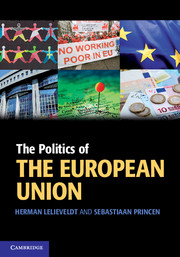Book contents
- Frontmatter
- Contents
- Acknowledgements
- List of briefings
- List of fact files
- List of controversies
- List of tables
- List of figures
- List of abbreviations and acronyms
- List of country abbreviations used in tables and figures
- Preface
- PART I Setting the scene: origins, analytical perspectives and institutions
- PART II Key actors in EU politics: citizens, interest groups and political parties
- Part III EU policies: agenda-setting, decision-making and implementation
- 8 An overview of EU policy-making
- 9 Agenda-setting
- 10 Decision-making
- 11 Implementing policies
- Conclusions and reflections
- Key terms and concepts
- Index
10 - Decision-making
from Part III - EU policies: agenda-setting, decision-making and implementation
- Frontmatter
- Contents
- Acknowledgements
- List of briefings
- List of fact files
- List of controversies
- List of tables
- List of figures
- List of abbreviations and acronyms
- List of country abbreviations used in tables and figures
- Preface
- PART I Setting the scene: origins, analytical perspectives and institutions
- PART II Key actors in EU politics: citizens, interest groups and political parties
- Part III EU policies: agenda-setting, decision-making and implementation
- 8 An overview of EU policy-making
- 9 Agenda-setting
- 10 Decision-making
- 11 Implementing policies
- Conclusions and reflections
- Key terms and concepts
- Index
Summary
Introduction
In the early hours of 17 December 2005, after long and complex negotiations, the European Council agreed to the EU's Financial Perspectives for the period 2007–13. The Financial Perspectives lay down the size of the EU budget for each year as well as the contribution of each member state and the distribution across major spending categories. This forms the framework within which annual budgets are adopted.
Finding a compromise had been a difficult process because the Financial Perspectives had to reconcile a number of highly diverging interests. To begin with, the EU faced the financial consequences of the 2004 enlargement with ten new member states, which put increasing pressure on the EU budget. Moreover, following the ambition set out in the Lisbon Strategy that the EU should become the most competitive economy in the world, the European Commission wanted to step up spending on research and development and other policies that stimulated economic growth.
At the same time, the room for manoeuvre in devising a budgetary deal was extremely limited. To begin with, the six largest net contributors to the EU budget (Austria, France, Germany, the Netherlands, Sweden and the UK) demanded that the EU budget should be capped at 1% of European Gross National Income (GNI), which implied a reduction from spending in the period 2000–6. Moreover, during negotiations in 2002, spending on the Common Agricultural Policy (CAP) had been fixed for the period until 2013.
- Type
- Chapter
- Information
- The Politics of the European Union , pp. 228 - 251Publisher: Cambridge University PressPrint publication year: 2011

